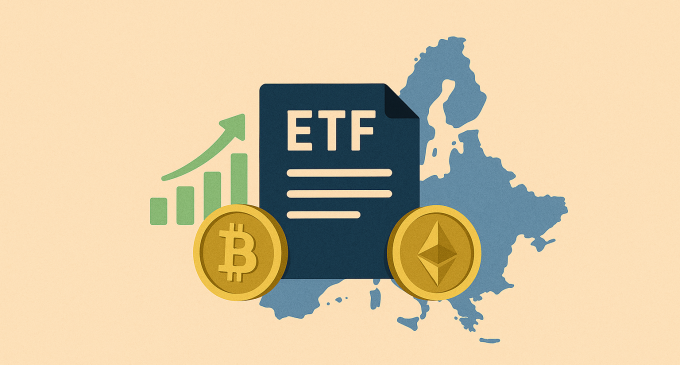
Introduction
The global cryptocurrency market is undergoing a paradigm shift, and at the heart of this transformation is the rapidly expanding adoption of Exchange-Traded Funds (ETFs) focused on digital assets. While the United States took the lead in early 2024 with the approval of the first spot Bitcoin ETFs, Europe is now preparing to enter this lucrative and high-demand sector. A wave of new European crypto ETFs is set to launch across key financial centers including Germany, Switzerland, and the Netherlands, reflecting a significant surge in institutional and retail interest. This transition marks a pivotal moment for the digital asset industry, offering new access points for traditional investors and potentially fueling the next phase of global crypto adoption.
What Are Crypto ETFs And Why They Matter?
Crypto ETFs are investment vehicles that allow individuals and institutions to gain exposure to cryptocurrencies like Bitcoin or Ethereum without directly purchasing or holding the digital assets themselves. Instead, these ETFs track the price of a specific cryptocurrency or a basket of assets, and they trade on regulated stock exchanges just like traditional ETFs. This structure offers greater accessibility, security, and regulatory transparency, especially for those who may be hesitant to use crypto wallets or interact with decentralized exchanges.
For institutional investors, ETFs provide a bridge between traditional finance and blockchain technology. For retail investors, they lower the barrier to entry by removing the complexities of managing crypto holdings. The success of spot Bitcoin ETFs in the U.S., which now collectively manage over $20 billion in assets, has highlighted the growing appetite for crypto investment products in traditional financial formats.
Europe’s Turn: The Push For Crypto ETF Adoption
Following the success of U.S. offerings, Europe’s financial institutions and regulators are accelerating efforts to introduce their own versions of crypto ETFs. Asset managers across Europe are working closely with regulatory bodies like the European Securities and Markets Authority (ESMA), Germany’s BaFin, and the UK’s Financial Conduct Authority (FCA) to ensure compliant product structures.
In June 2025, several major asset managers in Europe, including BlackRock’s European arm, 21Shares, CoinShares, and VanEck Europe, announced their intentions to launch new spot crypto ETFs in the coming months. These ETFs are expected to debut in Frankfurt, Zurich, and Amsterdam, which are emerging as the continent’s key crypto-financial hubs.
The European market is already familiar with crypto-linked products such as Exchange-Traded Notes (ETNs), which have been available for years on platforms like the Frankfurt Stock Exchange. However, full-scale ETFs are considered a more robust and regulated vehicle, offering broader investor protection and easier access through mainstream brokerage platforms.
Regulatory Green Lights: A Changing Landscape
One of the biggest obstacles to launching crypto ETFs in Europe has traditionally been the fragmented regulatory environment. Unlike the United States, which operates under a centralized body like the Securities and Exchange Commission (SEC), Europe’s regulatory landscape varies from country to country. That said, growing clarity and coordination among European Union regulators are now creating a more favorable environment for crypto ETF development.
In May 2025, ESMA released a revised framework for digital asset financial products, clarifying conditions under which ETFs could be approved. These guidelines emphasized secure custody solutions, accurate price tracking mechanisms, and transparent disclosures about risks. This regulatory clarity was a green light for asset managers who had been preparing ETF proposals for months, waiting for the right regulatory timing.
Moreover, the United Kingdom—although outside of the EU—has expressed interest in re-evaluating its stance on crypto ETFs, with consultations now underway regarding the use of blockchain in capital markets and ETF tracking.
Institutional Appetite And Market Demand
One of the strongest drivers behind this push into European crypto ETFs is the soaring demand from institutional investors. Pension funds, insurance companies, and hedge funds across the continent are increasingly looking for safe and regulated ways to gain exposure to digital assets. Unlike previous years where crypto investments were limited to tech-savvy individuals or crypto-native funds, 2025 is witnessing a broader adoption curve.
European financial advisors report rising interest from clients who want crypto exposure without managing wallets, security keys, or exchange risks. Crypto ETFs, traded on traditional stock markets, offer an ideal solution. These ETFs provide daily liquidity, compliance with local regulations, and the backing of reputable issuers—all crucial for large institutions subject to strict risk and compliance mandates.
Furthermore, the success of U.S. ETFs—such as BlackRock’s iShares Bitcoin Trust and Fidelity’s Wise Origin Bitcoin Fund—has created a sense of FOMO (fear of missing out) among European asset managers. Investors are watching BTC prices climb and ETF inflows grow, prompting urgency among firms that don’t want to be left behind in the rapidly evolving crypto investment landscape.
Technology And Infrastructure Readiness
Beyond regulatory readiness, the European financial ecosystem is increasingly capable of supporting crypto ETFs from a technological standpoint. Custody solutions, price tracking mechanisms, and blockchain analytics firms have matured significantly over the last three years.
Companies like Ledger Enterprise, BitGo Europe, and Fireblocks are offering secure institutional custody services, addressing one of the key concerns regulators have regarding digital asset products. Meanwhile, real-time pricing data providers and on-chain analytics firms are helping issuers maintain accurate net asset values (NAVs) and meet reporting standards.
Additionally, the integration of tokenization into traditional financial operations—such as tokenized bonds and real estate securities—is helping normalize blockchain within legacy systems. This convergence of old and new financial technologies is creating a perfect environment for launching more crypto-native products like ETFs.
The Competitive Landscape: Who’s Launching What?
Several players are currently vying for first-mover advantage in the European crypto ETF space. Below are some of the prominent contenders and their plans:
21Shares – Based in Switzerland, 21Shares already offers ETNs and is poised to launch Europe’s first spot Bitcoin ETF in Zurich.
CoinShares – A veteran in European digital asset management, CoinShares is expanding its suite with ETFs targeting both Bitcoin and Ethereum.
VanEck Europe – The firm is leveraging its U.S. experience to gain approvals in Germany and the Netherlands for both spot and futures-based ETFs.
BlackRock Europe – While still finalizing regulatory filings, BlackRock has expressed a strong intention to mirror its U.S. success across European platforms.
With multiple issuers competing for market share, the European market could soon see a robust range of offerings, including single-asset ETFs, basket products, and even actively managed crypto funds.
Impact On Crypto Markets And Global Adoption
The launch of crypto ETFs in Europe is expected to have a significant ripple effect on global crypto markets. Historically, major regulatory approvals in one region often influence others. With Europe joining the U.S. in embracing regulated ETFs, markets like Asia and Latin America may feel encouraged to explore similar paths.
Moreover, ETF launches often correlate with increased price stability and rising market caps for underlying assets. This is largely due to the inflow of capital from long-term investors and institutions who hold ETFs as part of diversified portfolios. As a result, Bitcoin, Ethereum, and even select altcoins may experience less volatility and higher floor prices, improving their case as long-term stores of value.
Crypto ETFs also represent a milestone in public legitimacy for the asset class. As more everyday investors see crypto ETFs alongside traditional equities and bonds on their brokerage dashboards, the perception of digital assets as speculative or fringe investments is likely to fade.
Challenges Ahead
Despite the optimism, challenges remain. Regulatory backlash is always a possibility, especially if markets become overheated or if a major ETF faces security or solvency issues. Moreover, crypto’s underlying volatility continues to pose a challenge for ETF managers who must maintain stable and liquid portfolios.
Additionally, the question of altcoin inclusion remains open. While Bitcoin and Ethereum are the most likely candidates for early ETFs, regulators are still cautious about approving products tied to lesser-known or more volatile assets. It may take additional time and market maturity before broader crypto ETFs can enter the European landscape.
Conclusion
The expected rollout of crypto ETFs in Europe marks a significant evolution in the global digital asset ecosystem. It reflects both the growing legitimacy of cryptocurrencies in institutional finance and the maturation of regulatory frameworks that support safe, transparent investment products. With the backing of major asset managers, robust custody infrastructure, and increasing investor demand, Europe is poised to become a key player in the next chapter of global crypto adoption.
As crypto ETFs begin trading on European exchanges in late 2025, the stage is set for accelerated investment, greater accessibility, and deeper integration between blockchain technology and traditional finance. This isn’t just a regional development—it’s a global signal that the age of regulated crypto investment has truly arrived.







There are no comments at the moment, do you want to add one?
Write a comment